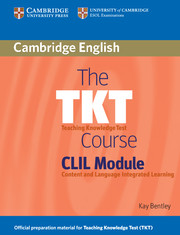Unit 1 - Aims of CLIL and rationale for CLIL
Published online by Cambridge University Press: 27 September 2023
Summary
What is CLIL?
CLIL, or Content and Language Integrated Learning, has many definitions. Here are some of them:
CLIL is an approach or method which integrates the teaching of content from the curriculum with the teaching of a non-native language. It is increasingly important in our global, technological society, where knowledge of another language helps learners to develop skills in their first or home language and also helps them develop skills to communicate ideas about science, arts and technology to people around the world. It gives learners a different learning experience compared with most foreign language teaching because in a CLIL classroom, the curricular subject and new language are taught together. Thinking and learning skills are integrated too. CLIL can involve many methodologies from both subject and language teaching, so CLIL presents new challenges for teachers and learners.
CLIL teachers can be subject teachers, language teachers, primary classroom teachers or classroom assistants. Different teachers have different challenges: language teachers need to learn more about subject content; subject teachers need to learn about the language needed for their subjects. In some programmes, there is cooperation between subject and language teachers. CLIL learners in schools are between three and eighteen years old and start CLIL at different ages. Others may be in vocational or academic study.
What are the benefits of CLIL?
CLIL aims to:
introduce learners to new concepts through studying the curriculum in a nonnative language
improve learners’ production of the language of curricular subjects
improve learners’ performance in both curricular subjects and the target language
increase learners’ confidence in the target language and the L1
provide materials which develop thinking skills from the start
encourage stronger links with values of community and citizenship
make the curricular subject the main focus of classroom materials.
We know from research that compared with learners who study English in ELT classes, most learners who start CLIL in primary schools are, by the time they finish primary education: more confident using the target language as well as their L1; more sensitive to vocabulary and ideas presented in the target language and in the L1; they have a more extensive and varied vocabulary; they reach higher levels of English than those reached in ELT courses.
- Type
- Chapter
- Information
- The TKT Course CLIL Module , pp. 5 - 10Publisher: Cambridge University PressPrint publication year: 2010

